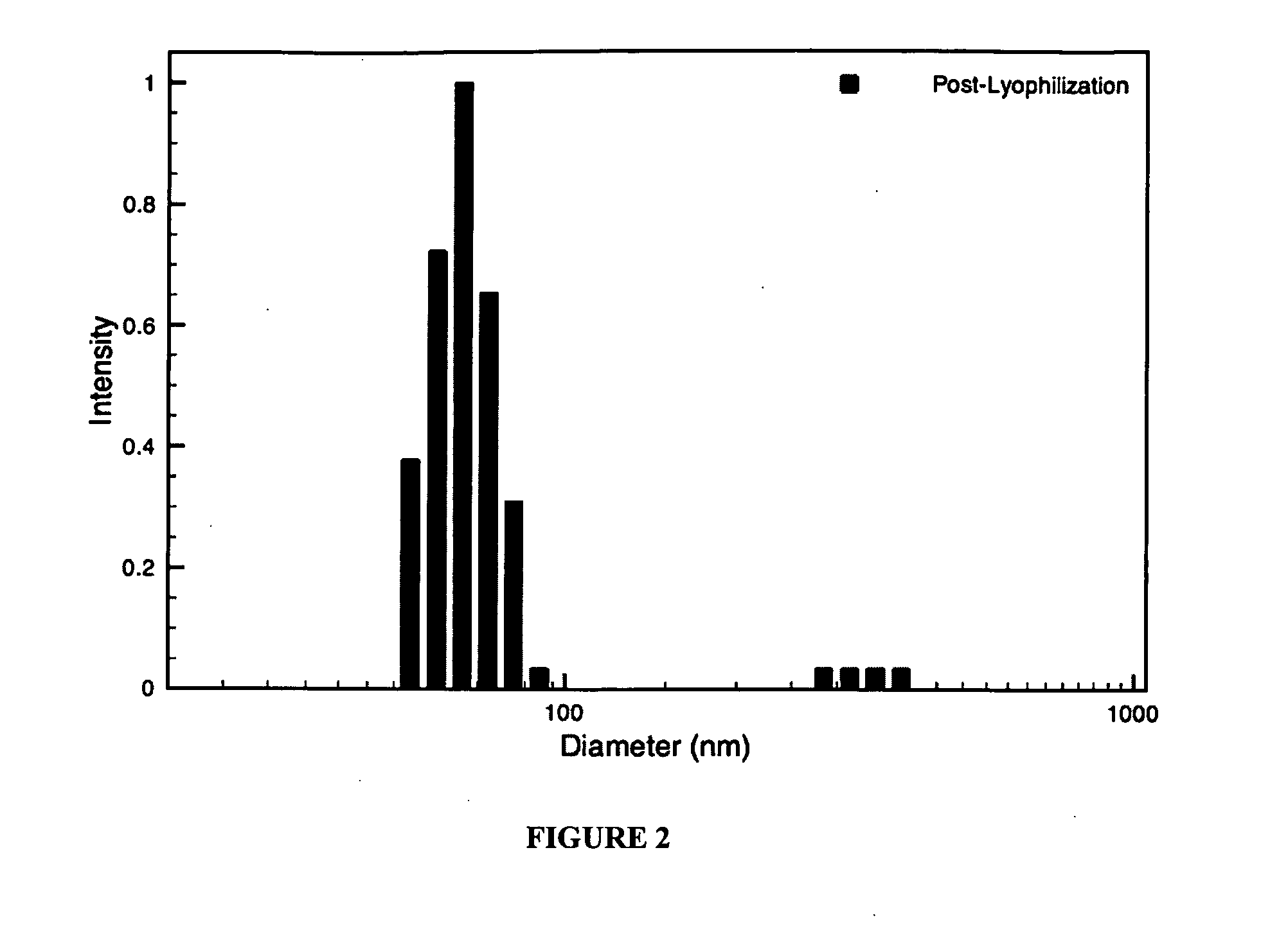Hybrid block copolymer micelles with mixed stereochemistry for encapsulation of hydrophobic agents
a technology of copolymer micelles and hydrophobic agents, applied in the field of polymer chemistry, can solve the problems of premature dissociation of drug-loaded micelles before active or passive targeting is effectively achieved
- Summary
- Abstract
- Description
- Claims
- Application Information
AI Technical Summary
Problems solved by technology
Method used
Image
Examples
example 1
[0339]
[0340]Synthesis of mPEG-hydrochloride—To a 500 mL 2-neck round bottom flask was added mPEG (40 g, 5 mmol), phthalimide (4.41 g, 30 mmol) and triphenyl phosphine (6.55 g, 25 mmol). The reagents were dissolved in anhydrous THF (300 mL) and stirred at room temperature. Once a homogeneous solution was present, DIAD (4.04 g, 20 mmol) was added and the solution stirred for 16 h. The solvent was evaporated and the residue purified by solid phase extraction (3% MeOH in CHCl3 (1 L) followed by 10% MeOH in CHCl3 (1 L) which contained the polymer product). The solvent was removed and the resulting liquid dissolved in ethanol (200 mL) and hydrazine hydrate (10 mL). The solution was stirred at reflux for 14 h, allowed to cool, then concentrated HCl (15 mL) was added dropwise to the solution. The solution was filtered and the solvent evaporated. The residue was dissolved in water and the polymer product extracted with CHCl3 (4×500 mL). The combined organic layers were dried over MgSO4, filt...
example 2
[0341]
[0342]Synthesis of mPEG-PAsp-(PAsp-co-DBzGlu)-Ac—To a 100 mL round bottom flask was added mPEG-hydrochloride (1.0 g, 0.13 mmol) and t-butyl aspartic acid NCA (0.28 g, 1.3 mmol). The reagents were dried under vacuum for 1 hour, then NMP (10 mL) added. The solution was degassed under vacuum the backfilled with N2, and stirred at 80° C. After 48 h, D-benzyl glutamate NCA (0.34 g, 1.3 mmol) and and t-butyl aspartic acid NCA (0.28 g, 1.3 mmol) was dissolved in NMP (5 mL) and added to the reaction. After an additional 48 h, the solution was allowed to cool, then DMAP (0.16 g, 1.3 mmol) and acetic anhydride (0.13 g, 1.3 mmol) added to the stirred solution. After 1 hour, the solution was precipitated into diethyl ether / hexanes (3:2, 300 mL). A white solid was recovered after filtration, which was dissolved in TFA / H2O (95:5, 40 mL) and stirred for 4 hours at room temperature. The solvent was evaporated and the residue precipitated into ether (300 mL). A white powder (0.7 g, 52% yield) ...
example 3
[0343]
[0344]Synthesis of Azide-PEG-TFA salt—Azide-PEG-BOC was dissolved in 1:1 TFA / CH2Cl2 (15 mL) and stirred at room temperature for 1 hour. The solvent was evaporated and the residue precipitated into ether. A white powder was recovered by filtration, which was redissolved in a minimal amount of methanol (40 mL) and again precipitated into ether. A white powder (2.6 g, 87% yield) was recovered after filtration. 1H NMR (400 MHz, DMSO-d6, δ) 7.72, 3.3-3.7, 2.98. GPC (DMF, PEG Standards) Mn=4,800; PDI=1.04.
PUM
| Property | Measurement | Unit |
|---|---|---|
| Hydrophobicity | aaaaa | aaaaa |
| Chemotherapeutic properties | aaaaa | aaaaa |
| Valence | aaaaa | aaaaa |
Abstract
Description
Claims
Application Information
 Login to View More
Login to View More - R&D
- Intellectual Property
- Life Sciences
- Materials
- Tech Scout
- Unparalleled Data Quality
- Higher Quality Content
- 60% Fewer Hallucinations
Browse by: Latest US Patents, China's latest patents, Technical Efficacy Thesaurus, Application Domain, Technology Topic, Popular Technical Reports.
© 2025 PatSnap. All rights reserved.Legal|Privacy policy|Modern Slavery Act Transparency Statement|Sitemap|About US| Contact US: help@patsnap.com



